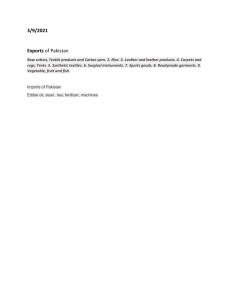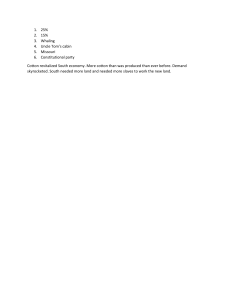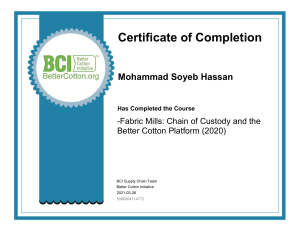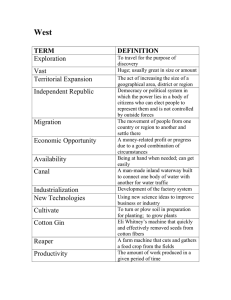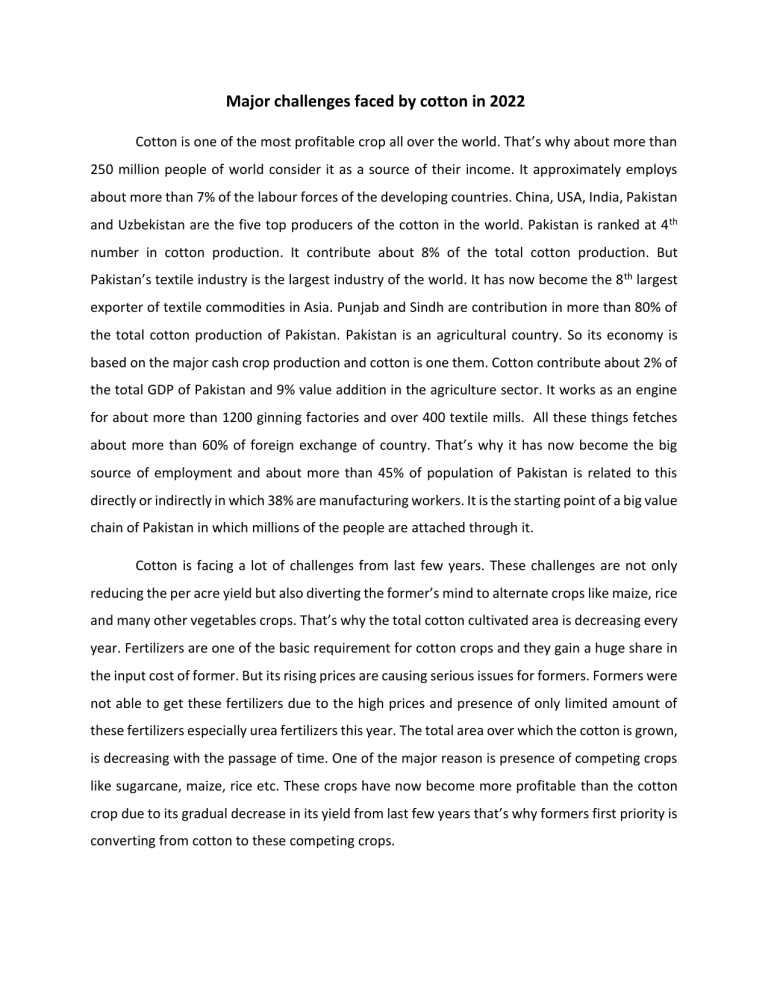
Major challenges faced by cotton in 2022 Cotton is one of the most profitable crop all over the world. That’s why about more than 250 million people of world consider it as a source of their income. It approximately employs about more than 7% of the labour forces of the developing countries. China, USA, India, Pakistan and Uzbekistan are the five top producers of the cotton in the world. Pakistan is ranked at 4 th number in cotton production. It contribute about 8% of the total cotton production. But Pakistan’s textile industry is the largest industry of the world. It has now become the 8 th largest exporter of textile commodities in Asia. Punjab and Sindh are contribution in more than 80% of the total cotton production of Pakistan. Pakistan is an agricultural country. So its economy is based on the major cash crop production and cotton is one them. Cotton contribute about 2% of the total GDP of Pakistan and 9% value addition in the agriculture sector. It works as an engine for about more than 1200 ginning factories and over 400 textile mills. All these things fetches about more than 60% of foreign exchange of country. That’s why it has now become the big source of employment and about more than 45% of population of Pakistan is related to this directly or indirectly in which 38% are manufacturing workers. It is the starting point of a big value chain of Pakistan in which millions of the people are attached through it. Cotton is facing a lot of challenges from last few years. These challenges are not only reducing the per acre yield but also diverting the former’s mind to alternate crops like maize, rice and many other vegetables crops. That’s why the total cotton cultivated area is decreasing every year. Fertilizers are one of the basic requirement for cotton crops and they gain a huge share in the input cost of former. But its rising prices are causing serious issues for formers. Formers were not able to get these fertilizers due to the high prices and presence of only limited amount of these fertilizers especially urea fertilizers this year. The total area over which the cotton is grown, is decreasing with the passage of time. One of the major reason is presence of competing crops like sugarcane, maize, rice etc. These crops have now become more profitable than the cotton crop due to its gradual decrease in its yield from last few years that’s why formers first priority is converting from cotton to these competing crops. Hundreds of the different varieties of cotton seed have been introduced into markets. But still there is deficiency in provision of quality seed, which should at least have more than 85% germination, proper resistance or immunity to the diseases and other insect pests of cotton and should also be able to compete with the changing climate of Pakistan. Germination percentage is one of the major issue. All the former faced this issue that their Bt varieties got infected by diseases and different types of insects. There was no any variety which should have more than 70% germination. Formers don’t sow their cotton crop on the proper date issued by the agriculture authorities of Pakistan. This was due to presence of previous crop in the field and formers sow their crops early in the season which was big threat for cotton insect pest like pink boll worm. All these things caused major yield losses which greatly impacted the overall cotton production of Pakistan. Proper sowing time is also responsible for the maximum germination of seed. Pakistan have faced more than 150 extreme events from last 25 years. Same in the case with other countries also. That’s why the average temperature of the world is also increasing gradually. In 2022, Pakistan faced major floods in its different areas. This was due to glaciers melting more than the normal routine just because of climate change. These floods caused great damages and destroyed all the crops of that areas including cotton. More than the half of cotton cultivated area was affected by these floods. This had ultimate effect on the overall cotton production of Pakistan. There has been shortage of canal irrigation water from last few years. That’s why formers are not availing this facility and are using their alternate source, tube wel, which is proved to be very costly due to the higher prices of electricity. Former faced a lot of problems in the leading year due to unavailability of canal irrigation water. This also increased the input costs for all the formers. Cotton pests have now become resistance to the present pesticides due to improper and continuous use of same pesticides from bundle of years. Agriculture authorities recommended not to spray any type of pesticide in field for at least first 60 years. But formers don’t follow these instructions and started applying the pesticides at the start or on appearance of insect pests. This mostly happened in case of happen in case of whitefly, aphid, jassid and thrips. That’s why these pests got resistance against all these pests early in the season and later application of these pesticides were not effective. And it became very difficult to control these pests at these later stages that’s why they caused a great losses to cotton crops and effected the yield also. Insect pests is a big problem in all the areas where cotton is growing. This is because the cotton insects readily become resistant against the pesticides and it becomes very difficult to control or manage them. All these insect pests have multiple hosts and that’s why they remain active for the whole year. Major Cotton pests which the former faced this year are Thrips, Jassid, Whitefly, Mealy bug, Aphid, Dusky cotton bug, Red cotton bug, Armyworm, Pink bollworm etc. Whitefly was a major issue this year also. It causes multiple type of damages. One of its main damage is that it is vector of cotton leaf curl virus. And it also participates in cotton blackening. Former failed to properly manage this pest properly. This is due to the improper, continuous and inappropriate use of insecticides, using untreated seed, presence of alternate host in nearby fields, improper plant spacing and irregular pest scouting. Mealy bug was not a big issue but still it was present in some fields. But all other insects like thrips, jassid, aphid, armyworm, pink bollworm etc was a big issue in the leading year also. Some important diseases seen this year are such as Cotton leaf curl virus, Leaf blight, Boll rot, Sooty mold, Plant wilting. Cotton leaf curl virus was a major issue in this year also. It was noticed in approximately in all the cotton fields. Its abrupt distribution was due to the presence of its vector. Sooty mold was also present in the field but not of that level as in previous year. Wilting was also present in some field but former controlled it at early stages by fungicides in the field. Boll rot and leaf blights were also present in the field but they were not so damaging. Government should take some steps to resolve these issues so that the cotton production should be improved and former should not face these issues in the next year.

